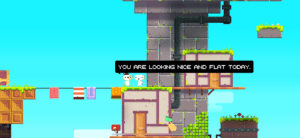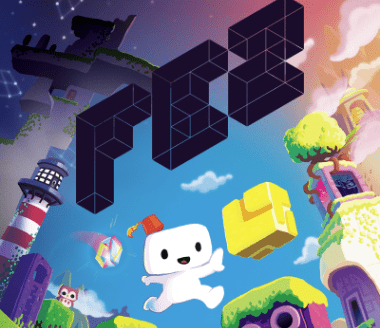For this week’s critical play, I chose to play Fez, a 2012 indie puzzle-platform game developed by Polytron Corporation and published by Trapdoor intended for 12+ year olds. The game is usually played on Nintendo Switch or PlayStation, but I played on my iPhone using the mobile app version.
Fez’ limited mechanics of running, jumping, and reading allows for players to focus on the fun of discovery and exploration, but the irreversible perspective shifting mechanic negatively affected the game’s cohesive narrative.

After entering through the first door and given the opening task of meeting the character Geezer, I understood the type of puzzles that I was being encouraged to complete. As pictured in the image, I really liked the animation style and different terrain material that encourages me to do trial and error or what was climbable, scalable, and able to be open/read. Unlike games like Super Mario with running, jumping, and climbing, the puzzles in Fez focused on perspective and meditative puzzles, such as rotating cubes to find hidden messages of exploring different rooms and doors to college resources. However, the constant shifting of perspective and various visual platforms made it hard to find my way around the game’s intricate web of levels. The fact that there was no undoing an action or easy way to return to the frame I was just mastering caused some frustration at times while playing the game. It was indeed rewarding to see that flat 2-D world were able to be transformed to a whole new 3-D viewpoint which continued to unlock a new space for exploration as the game went on.
I had one experience when the game seemed to start over immediately after I thought I unlocked a new level, but when the game restarted, I was at a new starting point with a different task. I didn’t like that it was not clear how to get back to the previous frame because it made the storyline and objective of the game’s narrative really confusing and even out of order. However, the simple mechanics definitely positively influenced my experience playing Fez because it forced me to understand that I needed to be collecting information from the current level I was playing in. The fact that there were hidden details in the background of every puzzle would not have been apparent if there were more complicated actions besides simple motions meant for discovery. If I had to make changes to the game, I would improve the map to be more comprehensive in a way that summarized or hinted at how I have progressed to the current level I was in. This would make the puzzle game’s narrative while playing as the character Gomez much more compelling and cohesive, which would keep me playing for longer. I also think that allowing players to resort back to a previous part of the game without have to restart and work their way back again would take away some sense of frustration and even increase motivation to continue exploring Gomez’ challenges and storyline. Another minor detail that affected my experience was the word font on some of the signs – I found it really difficult to read and this influenced how long I would spend trying to solve a certain puzzle.




